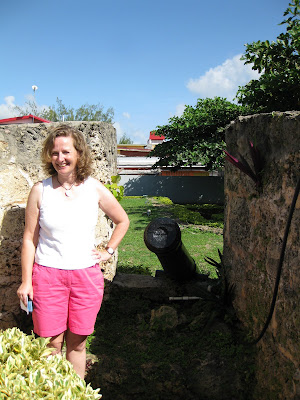Tobago is a very short flight (maybe 20 minutes) or a three hour ferry ride away. We had been warned that it could be a rough trip and came prepared with Dramamine and ginger ale. 90 minutes into the journey saw the roughest seas, and ferry employees started laying out barf bags on the bar and indeed several fellow travelers spent a lot of the trip with their heads on the table looking miserable, but that may have been a result of the in-flight entertainment: six consecutive episodes of the 90s sitcom "Martin". The great thing about the ferry was that we got to see a lot of Trinidad's coast - including our apartment as well as get a close look at the oil platform and tiny islands that we can see from our balcony.
The ferry arrived in Scarborough - the capital of Tobago - I think Tobago has just 60,000 people total so being the capital means that Scarborough is a town while everyplace else is a village with a small grocery and maybe a mobile phone store.
We headed first to Tobago's (only??) historic site - Fort Milford. Here's me with a cannon. The fort was made of rock and coral and had six cannons - most English but also one that is French - because the French very briefly occupied Tobago in the late 1700s.

Here's a view of Store Bay where we had lunch. Beach food in Trinidad is usually a fried fish sandwich called Shark 'n Bake and the one at Store Bay was outstanding. We learned that the secret to a Shark 'n Bake is the condiments - options include garlic sauce, chadon beni sauce (a Spanish sauce with cilantro and sounds like "shadow benny"), tamarind sauce, lettuce, tomatoes and many, many types and potencies of hot sauce.

Our hotel was in the town of Speyside - a town we chose because we met a Trini guy at a reception at the German Embassy and he said it was his favorite town. We decided to take the long way to Speyside following the western shore which is the Caribbean Sea - not realizing that the long way would be very long indeed because the roads were very windy following the coast. We did drive by this mural which we admired...

After many hours of driving, we had some conflicting information about whether the last 10 miles (or last 2 coves) were paved or not so we decided to cross the island by going through the National Forest. There were multiple signs about not grazing your animals there but we saw plenty of cows including this one which was topped with an egret.

Finally we made it to Speyside which is on the Atlantic side of Tobago. On Saturday we had the beach to ourselves and collected literally handfulls of beach glass - quadrupling my lifetime of collecting. I think beach glass is hard to find in the states because littering isn't as common as it once was - but in Tobago there was plenty of glass mostly in the colors of the two local beers - Stag (brown glass) and Carib (white glass)

On Sunday, we went to Argyle Falls which is a park on the site of a former cocoa plantation. Our tour guide pointed out birds including this jacamar - which is much prettier than our picture suggests.

We ended our weekend back in Scarborough and spent most of the time in the botanical gardens where they had some terrific Christmas decorations but also these very odd angels.











































